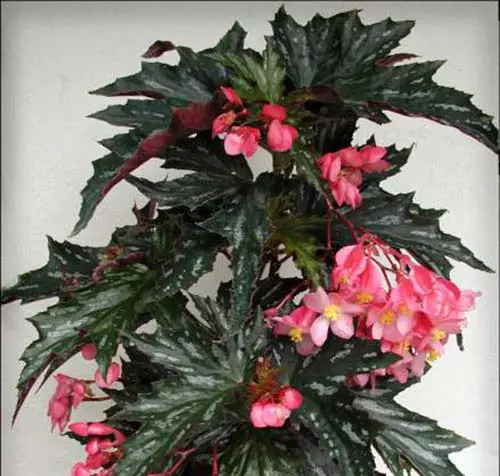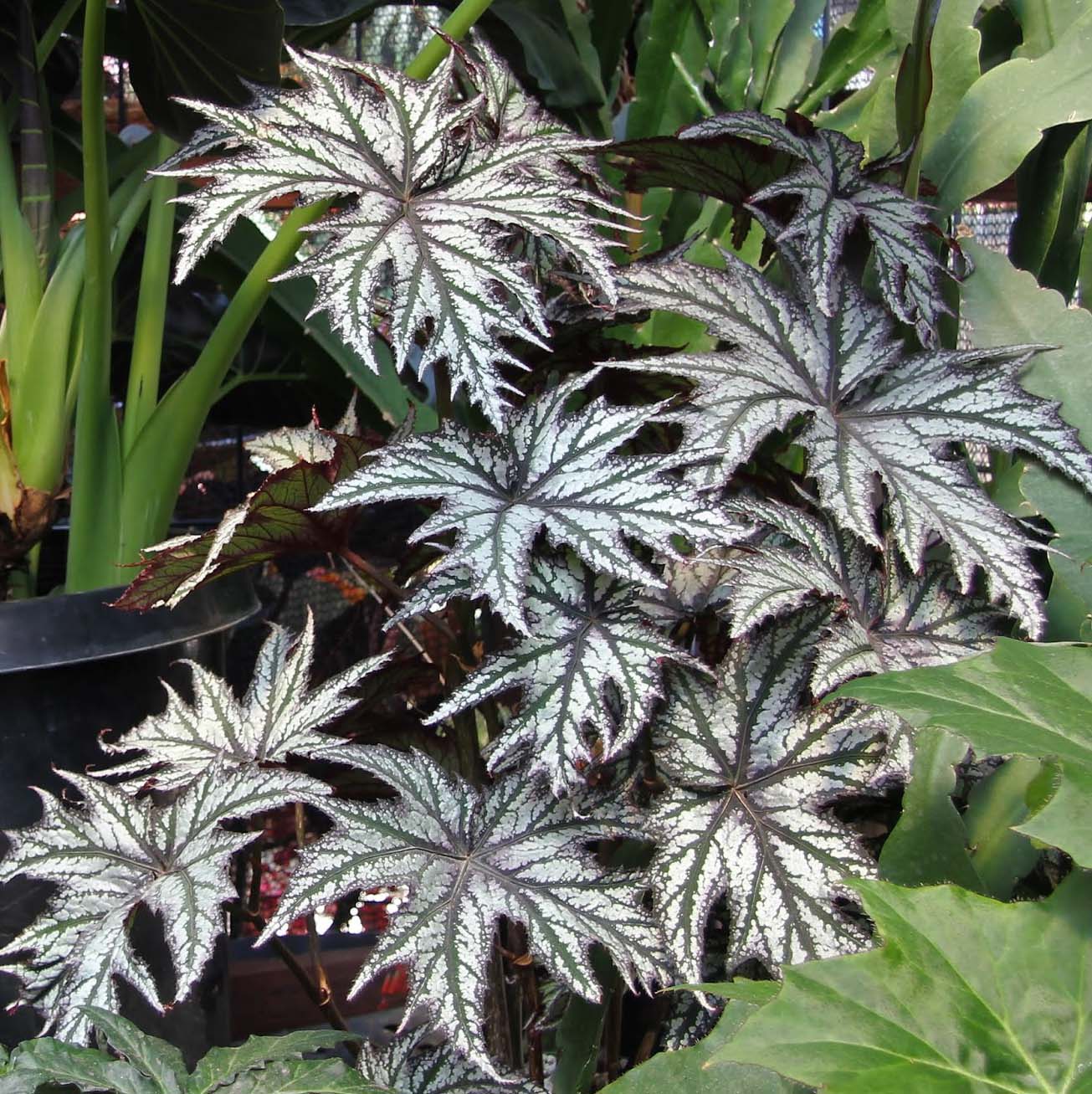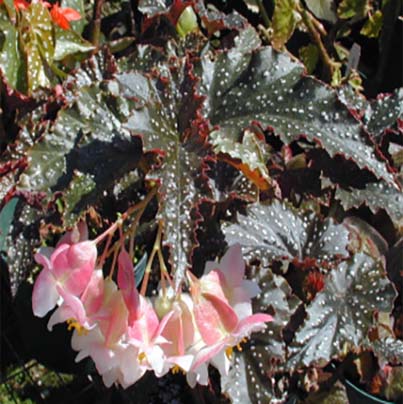by Brad Thompson
Until Freda suggested this article I guess I never consciously thought about the artistic aspects of the begonias I was creating. I suppose years of art classes made artistic goals mostly ingrained in everything I do. I must admit, upon reflection, that I do think of my begonia hybrids as a type of living art. Creating this type of living art, using chromosomes instead of paint, does throw in the element of chance and surprise to the work.
People are attracted to begonias for the same reasons they are attracted to beautiful paintings and works of art. They are pleasing to the eye and a joy to look at. I suppose some begonias might be considered more beautiful than others, but I have always been able to see the little things that make each unique. Things such as leaf color patterns, textures, and shapes. Those are what make begonias attractive to me. When choosing parents to use, I try to use two parents that have many interesting traits in the hopes that the best of these traits will combine in some new way.
B. ‘Mr. Hunt’ bred by Brad Thompson (B. ‘Connee Boswell’ × B. ‘Little Brother Montgomery’ ) | Photo: Gary Hunt
Although there is always the unexpected and chance in hybridizing, to be successful, you do have to have enough imagination to envision what to expect from crossing two parents together. Especially if you want to create something truly different, you have to have this ability. I have had people come to me and say, “I just self-pollinated B. ‘Orange Rubra’ and got two hundred seedlings coming up.” They are so excited and I ask them why they did that cross and what did they expect to get. They tell me they just love the orange flowers. They didn’t think ahead to envision that those seedlings will all be slightly different versions of B. ‘Orange Rubra’ and they wouldn’t really be coming up with something unique. Now, if they had crossed B. ‘Orange Rubra’ with B. ‘Charles Jaros’, that would be a different story. B. ‘Orange Rubra’ has the beautiful orange flowers and B. ‘Charles Jaros’ has wonderful cut silver leaves.
I can already envision the B. ‘Charles Jaros’ with orange flowers. If you’re going to go to the trouble to pollinate flowers and grow seed, make it worthwhile and interesting.
My goal in hybridizing is to come up with the most unique and beautiful Begonia I can envision. Sometimes this is a slight or minor change such as different colored flowers, but more often I am looking for a totally new artistic creation. We sometimes think that everything that can be created in begonias has already been done to some extent. That isn’t so. Try this experiment. Close your eyes and envision all the begonias you know. Now envision all those begonias with the texture of B. gehrtii added to them. There’s a few hundred new begonias that are totally different, that have just been dreamed up. It doesn’t take too much imagination to envision a cane with B. luxurians leaves, a shrub with B. paulensis texture, or a cane with spiral, patterned leaves like a rhizomatous.
Besides the forethought into the parents and what might result, a good share of the artistic eye toward hybridizing comes in the culling process. As anyone who has grown Begonia seed knows, you can have hundreds of seedlings from a single seed pod. Of course, most of us don’t have the room to grow them all to maturity so only the ones we consider the best get to grow on. For some seedlings, they are selected according to the vision that I had for them. If I were trying for a Superba cane with orange flowers, the seedlings with the most interesting leaves are selected with the vision of orange flowers waiting for the time when they bloom. Many seedlings take on their own artistic vision after they are up and growing though. Like I said before, there are surprises in hybridizing, and many of my crosses are made with surprises in mind. Planned surprises. I know what can result, but not exactly how those aspects will combine. If I were to cross B. gerhtii which has heavily textured leaves with a very patterned rhizomatous such as B. ‘Fred Benson’ I would expect that I’ll get a rhizomatous begonia with patterned and textured leaves. The most eye pleasing combinations are the ones that get to grow and eventually become named varieties. In this example, while all the results are a surprise, they aren’t complete surprises. I know the leaves should be textured and patterned, just not exactly how those two aspects will combine.
When it comes to naming your creations, you can add an artistic flair to that also. Anyone who has done any hybridizing has to name some of them for friends, etc., but for the others a creative name doesn’t hurt its eventual popularity. Many of my hybrids’ names were inspired by things they reminded me of. My snake series got their names because the leaf patterns reminded me of the different patterns on snakes. B. ‘Stormy Night’ and B. ‘Curly Stormy Night’ have black leaves and were named during a thunderstorm. B. ‘Dancing Birds’ with its upward pointing leaves reminded me of a flock of birds taking flight. I have several canes with Japanese names that were all named because they reminded me of some aspect of Asian painting or design.
Just as with painting, all the begonias you create should be new and unique. You can paint a copy of the Mona Lisa, but it wouldn’t be nearly as fine as if you painted a creation on your own. There can be only one real Mona Lisa. Use Begonia parents that have many unique qualities that you can hope to combine in new and different ways.




